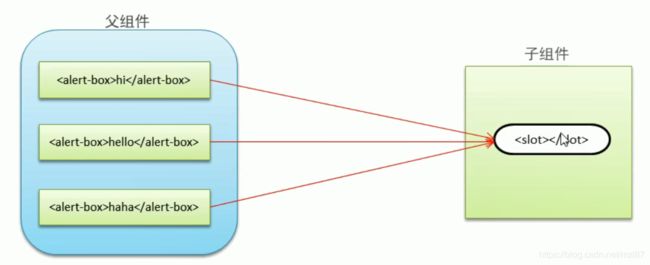Vue学习笔记(二) —— 组件开发
简介
在了解了Vue语法的基础知识和常用特性之后,在进行正式的开发之前,非常有必要的对组件化的相关知识进行了解。本文就是为介绍组件的相关知识点的。
1、组件化开发思想
现实生活中的组件化思想主要是:标准,分治,重用和组合。而软件上的组件化思想,其实都是对上面所说的进行抽象表示,然而每种语言所用的标准可能又不相同。
组件化规范:Web Components
但是这个规范并不是所有的浏览器都支持
- 我们希望尽可能多的重用代码
- 自定义组件的方式不太容易(
html,css和js) - 多次使用组件可能导致冲突
Web Components 通过创建封装好功能的定制化元素来解决上述问题。
其官网地址为:https://developer.mozilla.org/zh-CN/docs/Web/Web_Components。
Vue部分的实现了上述规则。
2、组件注册
2.1 全局组件注册语法
Vue.component(组件名称 ,{
data: 组件数据,
template: 组件模板内容
})
以下是定义组件的具体例子。
// 定义一个名为button-counter的新组件
Vue.component('button-counter',{
data: function () {
return {
count : 0
}
},
template : ''
})
2.2 组件的用法
<div id="app">
<button-counter>button-counter>
div>
<div id="app">
<button-counter>button-counter>
<button-counter>button-counter>
<button-counter>button-counter>
div>
2.3 组件注册的注意事项
-
data 必须是一个函数
- 分析函数和普通对象的对比
-
组件模板内容必须是单个根元素
- 分析演示实际的效果
-
组件模板内容可用是模板字符串
- 模板字符串需要浏览器提供支持(
ES6语法) - 即模板内容使用反引号(tab键上面那个键)包裹,可多行显示,可读性强。(正常是用单引号包裹的)
- 模板字符串需要浏览器提供支持(
-
组件命名方式
- 短横线方式
- 驼峰方式
Vue.component('my-component',{ /*...*/})
Vue.component('MyComponent',{ /*...*/})
如果使用驼峰式命名组件,那么在使用组件的时候,只能在字符串模板中用驼峰的方式使用组件;但是在普通的标签模板中,必须使用短横线的方式使用组件。
2.4 局部组件注册
var ComponentA = { /* ... */}
var ComponentB = { /* ... */}
var ComponentC = { /* ... */}
new Vue({
el: '#app',
components: {
'component-a': ComponentA,
'component-b': ComponentB,
'component-c': ComponentC
}
})
局部组件只能在组测它的父组件中使用,其他地方不可以使用。
3、Vue调试工具
3.1 安装调试工具
安装步骤:
- 克隆仓库
- 安装依赖包
- 构建
- 打开
chrome扩展页面 - 选中开发者模式
- 加载已经解压的扩展,选中
shells/chrome
可用很直观的查看组件之间的层次关系。
4、组件间的数据交互
4.1 父组件向子组件传值
1、组件内部通过props接收传递过来的值
Vue.component('menu-item',{
props: ['title'],
data: function() {
return {
msg: '子组件本身的数据'
}
}
template:'{{ msg + "-------" + title }}'
})
2、父组件通过属性将值传递给子组件
<menu-item title="来自父组件的数据">menu-item>
<menu-item :title="title">menu-item>
3、props属性名规则
-
在props中使用驼峰形式,模板中需要使用短横线的形式
-
字符串形式的模板中没有这个限制
Vue.component('menu-item', {
// 在javascript中是驼峰式的
props: ['menuTitle'],
template: '{{ menuTitle }}'
})
<!-- 在html中是短横线方式的 -->
<menu-item menu-title="nihao"></menu-item>
4、props属性值类型
- 字符串
String - 数值
Number - 布尔值
Boolean - 数组
Array - 对象
Object
4.2 子组件向父组件传值
props传递数据原则:单项数据流。即父组件可通过props向子组件传递数据,不建议通过props从子组件向父组件传值。
1、子组件通过自定义事件向父组件传递信息
<button v-on:click='$emit("enlarge-text")'>扩大字体button>
2、父组件监听子组件的事件
<menu-item v-on:enlarge-text='fontSize += 0.1'>menu-item>
3、子组件通过自定义事件(带参数)向父组件传递信息
<button v-on:click='$emit("enlarge-text",0.1)'>扩大字体button>
<menu-item v-on:enlarge-text='fontSize += $event'>menu-item>
4.3 非父子组件间传值
1、单独的事件中心管理组件间的通信
var eventHub = new Vue()
2、监听事件与销毁事件
eventHub.$on('add-todo',addToDo)
eventHub.$off('add-todo')
3、触发事件
eventHub.$emit('add-todo',id)
5、组件插槽
5.1 组件插槽的作用
5.2 组件插槽级别用法
1、插槽位置
Vue.conmponent('alert-box', {
template: `
Error:
默认内容
`
})
2、插槽内容和显示效果
<alert-box>有一个bugalert-box>
<alert-box>有一个警告alert-box>
<alert-box>alert-box>
Error:有一个bug
Error:有一个警告
Error:默认内容
5.3 具名插槽用法
1、插槽定义
<div class="container">
<header>
<slot name="header">slot>
header>
<main>
<slot>slot>
main>
<footer>
<slot name="footer">slot>
footer>
div>
2、插槽内容
<base-layout>
标题内容h1>
<p>主要内容1p>
<p>主要内容2p>
<p name="footer">底部内容p>
base-layout>
<base-layout>
<h1>标题内容h1>
<h1>标题内容h1>
tempalte>
<p>主要内容1p>
<p>主要内容2p>
<tempalte name="footer">
<p>底部内容p>
<p>底部内容p>
tempalte>
base-layout>
5.4 作用域插槽
- 应用场景:父组件对子组件的内容进行加工处理。
1、插槽定义
<ul>
<li v-for="item in list" v-bind:key="item.id">
<slot v-bind:item="item">
{{ item.name }}
slot>
li>
ul>
2、插槽内容
<fruit-list v-bind:list="list">
<template slot-scope="slotProps">
<strong v-if="slotProps.item.current">
{{ slotProps.item.text}}
strong>
template>
fruit-list>
总结
组件化的开发,可以让我们在实际的项目中对很多公共的功能进行抽取,从而实现重用。当然,本文中的很多知识点不是只看看就能理解的,需要手动的编码去感受代码的实现细节,并加深理解。接下来是关于前后的交互的相关总结,有兴趣的也可看看。



